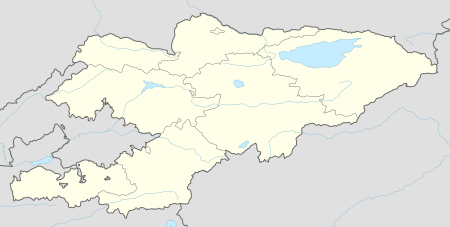Daroot-Korgon
Daroot-Korgon (also Darautkorgon or Daroot-Qurghan) is a village in the western Alay Valley of Osh Region, Kyrgyzstan. It is the capital of Chong-Alay District. Its population was 4,726 in 2009.[1] It is about 90 km west of Sary-Tash on the Kyzyl-Suu River. To the north is a route to Osh via the Tengizbay pass, used by Russian explorers before the construction of the road though Sary-Tash.
Daroot-Korgon Дароот-Коргон | |
|---|---|
 Daroot-Korgon | |
| Coordinates: 39°33′12″N 72°12′0″E | |
| Country | Kyrgyzstan |
| Region | Osh Region |
| District | Chong-Alay District |
| Elevation | 2,469 m (8,100 ft) |
| Population (2009) | |
| • Total | 4,726 |
| Time zone | UTC +5 |
To the south, the Altyn River flows north though a deep valley in the Trans-Alay Range. At the head of the valley is a Tajik border post and then Altyn Mazar on the Muksu River which flows west to join the Kyzyl-Suu. South of this is the foot of the Fedchenko Glacier.
The village of Kara-Shivak is 3 km (2 mi) to the south, and Kara-Su is 5 km (3 mi) to the east.
Aurel Stein suggested that this was the location of the "Stone Tower" that Ptolemy said was the place where caravans from the Chinese and Roman Empires met and exchanged goods.[2][3] Other scholars, however, disagree with this identification, though it remains one of four most probable sites for the Stone Tower.[4]
References
- "2009 population census of the Kyrgyz Republic: Osh Region" (PDF). Archived from the original (PDF) on 10 August 2011. Retrieved 2011-08-10.
- John E. Hill, Through the Jade Gate,2015, Appendix E. quoting Stein(1932), pp 22-23 and Stein(1928), vol II, pp-847-850. Hill's extract does not explain Stein's reasons.
If this is true the route east to Kashgar is obvious. The route west would have gone about 25 miles south up the Altyn River and down a 2000-foot slope to the Tadjik border post at Altyn Mazar ('Golden Shrine'). It would follow the Muksu 55 miles west to its junction with the Kyzyl-Suu. It would then follow the Vakhsh River about 140 miles west-southwest until the country becomes flat and then southwest to Balkh. Alternatively the route could have followed the Kyzyl-Suu west until its junction with the Muksu. The hill above Altyn Mazar looks difficult. but if the Kyzyl-Suu route were used there would be no reason for Daroot-Korgan to be a landmark, unless it was some kind of border post. - Stein, Aurel (1928). Innermost Asia: Detailed Report of Explorations in Central Asia, Kansu, and Eastern Īrān Carried Out and Described under the Orders of H.M. Indian Government (4 Volumes). Oxford: Clarendon Press. pp. 847–51 (Vol 2).
- Dean, Riaz (2015). "The Location of Ptolemy's Stone Tower: the Case for Sulaiman-Too in Osh". The Silk Road. 13: 77.